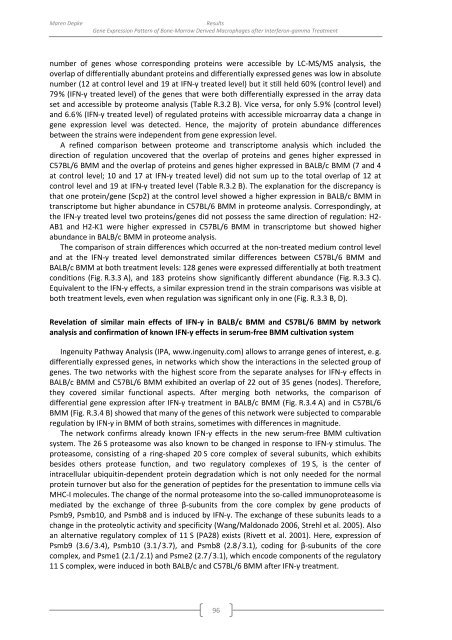genomewide characterization of host-pathogen interactions by ...
genomewide characterization of host-pathogen interactions by ...
genomewide characterization of host-pathogen interactions by ...
Create successful ePaper yourself
Turn your PDF publications into a flip-book with our unique Google optimized e-Paper software.
Maren Depke<br />
Results<br />
Gene Expression Pattern <strong>of</strong> Bone-Marrow Derived Macrophages after Interferon-gamma Treatment<br />
number <strong>of</strong> genes whose corresponding proteins were accessible <strong>by</strong> LC-MS/MS analysis, the<br />
overlap <strong>of</strong> differentially abundant proteins and differentially expressed genes was low in absolute<br />
number (12 at control level and 19 at IFN-γ treated level) but it still held 60 % (control level) and<br />
79 % (IFN-γ treated level) <strong>of</strong> the genes that were both differentially expressed in the array data<br />
set and accessible <strong>by</strong> proteome analysis (Table R.3.2 B). Vice versa, for only 5.9 % (control level)<br />
and 6.6 % (IFN-γ treated level) <strong>of</strong> regulated proteins with accessible microarray data a change in<br />
gene expression level was detected. Hence, the majority <strong>of</strong> protein abundance differences<br />
between the strains were independent from gene expression level.<br />
A refined comparison between proteome and transcriptome analysis which included the<br />
direction <strong>of</strong> regulation uncovered that the overlap <strong>of</strong> proteins and genes higher expressed in<br />
C57BL/6 BMM and the overlap <strong>of</strong> proteins and genes higher expressed in BALB/c BMM (7 and 4<br />
at control level; 10 and 17 at IFN-γ treated level) did not sum up to the total overlap <strong>of</strong> 12 at<br />
control level and 19 at IFN-γ treated level (Table R.3.2 B). The explanation for the discrepancy is<br />
that one protein/gene (Scp2) at the control level showed a higher expression in BALB/c BMM in<br />
transcriptome but higher abundance in C57BL/6 BMM in proteome analysis. Correspondingly, at<br />
the IFN-γ treated level two proteins/genes did not possess the same direction <strong>of</strong> regulation: H2-<br />
AB1 and H2-K1 were higher expressed in C57BL/6 BMM in transcriptome but showed higher<br />
abundance in BALB/c BMM in proteome analysis.<br />
The comparison <strong>of</strong> strain differences which occurred at the non-treated medium control level<br />
and at the IFN-γ treated level demonstrated similar differences between C57BL/6 BMM and<br />
BALB/c BMM at both treatment levels: 128 genes were expressed differentially at both treatment<br />
conditions (Fig. R.3.3 A), and 183 proteins show significantly different abundance (Fig. R.3.3 C).<br />
Equivalent to the IFN-γ effects, a similar expression trend in the strain comparisons was visible at<br />
both treatment levels, even when regulation was significant only in one (Fig. R.3.3 B, D).<br />
Revelation <strong>of</strong> similar main effects <strong>of</strong> IFN-γ in BALB/c BMM and C57BL/6 BMM <strong>by</strong> network<br />
analysis and confirmation <strong>of</strong> known IFN-γ effects in serum-free BMM cultivation system<br />
Ingenuity Pathway Analysis (IPA, www.ingenuity.com) allows to arrange genes <strong>of</strong> interest, e. g.<br />
differentially expressed genes, in networks which show the <strong>interactions</strong> in the selected group <strong>of</strong><br />
genes. The two networks with the highest score from the separate analyses for IFN-γ effects in<br />
BALB/c BMM and C57BL/6 BMM exhibited an overlap <strong>of</strong> 22 out <strong>of</strong> 35 genes (nodes). Therefore,<br />
they covered similar functional aspects. After merging both networks, the comparison <strong>of</strong><br />
differential gene expression after IFN-γ treatment in BALB/c BMM (Fig. R.3.4 A) and in C57BL/6<br />
BMM (Fig. R.3.4 B) showed that many <strong>of</strong> the genes <strong>of</strong> this network were subjected to comparable<br />
regulation <strong>by</strong> IFN-γ in BMM <strong>of</strong> both strains, sometimes with differences in magnitude.<br />
The network confirms already known IFN-γ effects in the new serum-free BMM cultivation<br />
system. The 26 S proteasome was also known to be changed in response to IFN-γ stimulus. The<br />
proteasome, consisting <strong>of</strong> a ring-shaped 20 S core complex <strong>of</strong> several subunits, which exhibits<br />
besides others protease function, and two regulatory complexes <strong>of</strong> 19 S, is the center <strong>of</strong><br />
intracellular ubiquitin-dependent protein degradation which is not only needed for the normal<br />
protein turnover but also for the generation <strong>of</strong> peptides for the presentation to immune cells via<br />
MHC-I molecules. The change <strong>of</strong> the normal proteasome into the so-called immunoproteasome is<br />
mediated <strong>by</strong> the exchange <strong>of</strong> three β-subunits from the core complex <strong>by</strong> gene products <strong>of</strong><br />
Psmb9, Psmb10, and Psmb8 and is induced <strong>by</strong> IFN-γ. The exchange <strong>of</strong> these subunits leads to a<br />
change in the proteolytic activity and specificity (Wang/Maldonado 2006, Strehl et al. 2005). Also<br />
an alternative regulatory complex <strong>of</strong> 11 S (PA28) exists (Rivett et al. 2001). Here, expression <strong>of</strong><br />
Psmb9 (3.6 / 3.4), Psmb10 (3.1 / 3.7), and Psmb8 (2.8 / 3.1), coding for β-subunits <strong>of</strong> the core<br />
complex, and Psme1 (2.1 / 2.1) and Psme2 (2.7 / 3.1), which encode components <strong>of</strong> the regulatory<br />
11 S complex, were induced in both BALB/c and C57BL/6 BMM after IFN-γ treatment.<br />
96

















